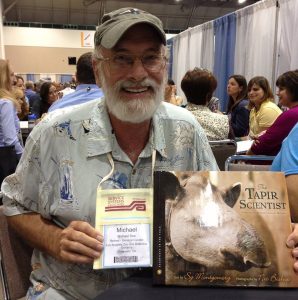In September 2017, the tapir conservation world has lost a supporter, a mentor, a friend, and just a wonderful human being and soul in Michael Dee. Mike was the former General Curator at the Los Angeles Zoo in the United States and a very close friend and active member of the IUCN/SSC Tapir Specialist Group (TSG).
The TSG is honoring Mike Dee and his contributions to tapir conservation by establishing a new annual tapir grant program, the MICHAEL DEE MOUNTAIN TAPIR CONSERVATION GRANT. This will be an annual grant from the TSG, fully focused on mountain tapir research and conservation in Colombia, Ecuador and Peru.

How To Contribute:
If you would like to contribute to the Michael Dee Mountain Tapir Conservation Grant, please send your donation to:
IUCN Tapir Specialist Group
ATTN: Kelly Russo
IUCN TSG Marketing & Education Committee Coordinator
3111 Buckner Court
Missouri City, Texas 77459 USA
Please make CHECK payable to the IUCN Tapir Specialist Group and let us know your donation should go to the MICHAEL DEE MOUNTAIN TAPIR CONSERVATION GRANT.
Please e-mail: epmedici@uol.com.br and/or kelly@russo.com if you have any questions.
2017-2018 Michael Dee Mountain Tapir Conservation Grant Recipient
Caterina Cosmopolis, Peru
Project Description:
Districtution of Tapirus pinchaque in Northern Peru and the Main Conflict Areas For It’s Conservation
This study focuses on complement the distribution map of Tapirus pinchaque in Peru and to identify the main conflicted areas for its conservation. The mountain tapir has been poorly studied in Peru, and only reported in three sites in Northern Peru: Tabaconas Namballe National Sanctuary, Paigabamba Protection Forest (both in Cajamarca) and the Cañaris province (in Lambayeque). The main threats for T. pinchaque conservation are due to cattle introduction in their habitat and the lack of large protected areas to maintain viable populations. Among them, the absence of large protected areas, as well as the weak policies of the peruvian government, have the greatest impact on its conservation. Thus, the conservation of this species depends on managing the use of resources and the creation corridors to complement the protection of the mountain tapir.

Since Tapirus pinchaque distribution in Piura region is uncertain, this study will be carried out in ACP Bosques Montanos y Páramos Chicuate – Chinguelas, ACP Bosques de Neblina y Páramos de Samanga and ACR Pacaipampa, situated in that region. The aims of this study are to 1) gather and analyse secondary information about T. pinchaque and determine its distribution on the study sites and their surroundings, 2) conduct a preliminary identification of conflict areas with local communities and primary threats around the study sites, and 3) estimate the population density of T. pinchaque using camera traps. Cameras will be set in a grid with distances between cameras of 800m and at a height of 50cm above the ground. Cameras will be in constant operation for a month period, where batteries and memory cards will be replaced. Tapirs will be identified based on skin marks, scars, tail length and shape, sex, ear shape and notches, size, and other outstanding features.
Results and conclusions of this study will help to manage and protect mountain tapir in and around private conservation areas and areas of human habitation. Additionally, as the information gets published, it will contribute to the knowledge of Tapirus pinchaque conservation status in Peru.
